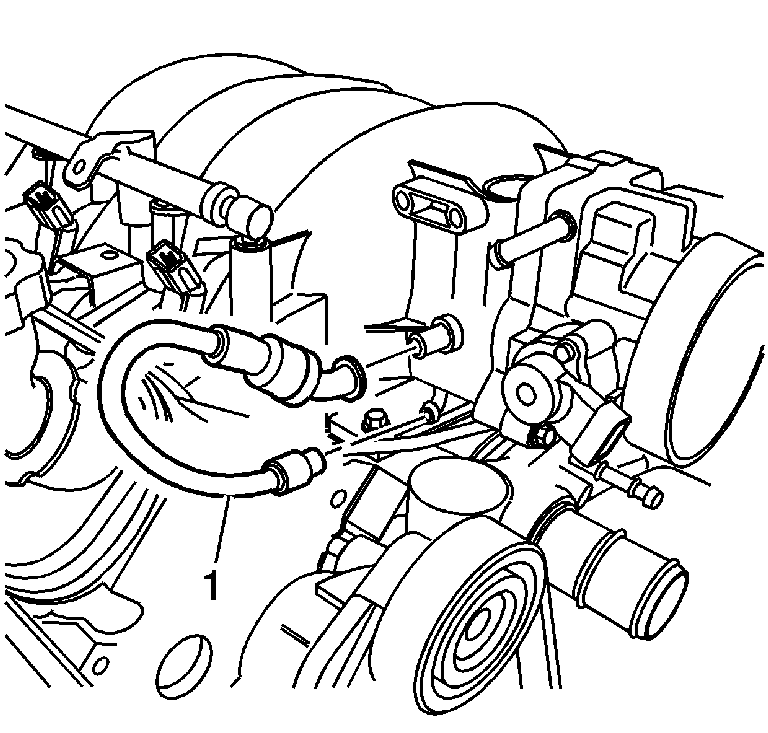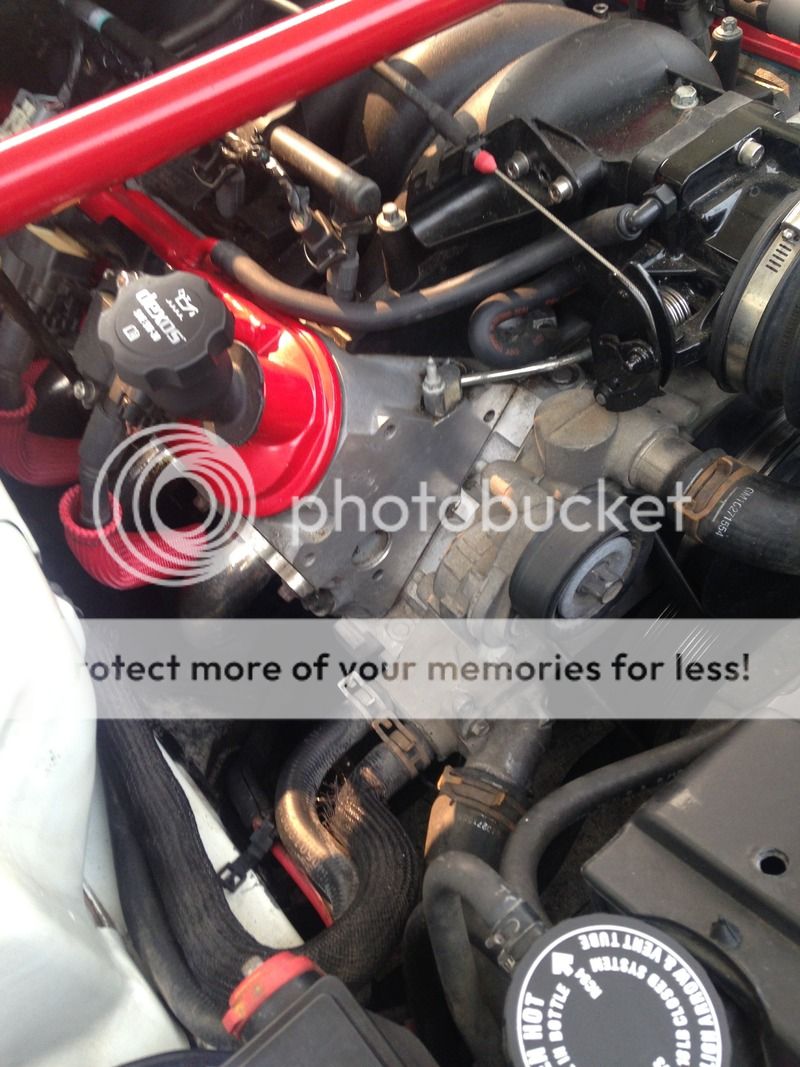LS1 / LS6 PCV system (connected up wrong?)
#1
Thread Starter
TECH Apprentice
iTrader: (1)
Joined: Sep 2016
Posts: 322
Likes: 3
From: Leicester, United Kingdom
Hi all,
I'm currently trying to fathom out how my PCV system should be routed on my 2001 LS1.
It has an LS6 valley cover fitted by a previous owner but it seems the built in PCV part has never been used. The pipe which exits the valley at the front of the cover is still blanked off with a red stopper. I have a pipe coming from the throttle body top connection which goes to the vent pipe on the passenger side valve cover and a larger hose coming from the intake port to a PCV valve and then a larger hose which travels along the passenger valve cover, splits into two at the back of the engine - 1 smaller tube goes somewhere I can't see and the othernone connects to a fitting on the back side of the drivers valve cover.
To make use of the LS6 valley cover, how should I be reconnecting the pipes up?
I'm currently trying to fathom out how my PCV system should be routed on my 2001 LS1.
It has an LS6 valley cover fitted by a previous owner but it seems the built in PCV part has never been used. The pipe which exits the valley at the front of the cover is still blanked off with a red stopper. I have a pipe coming from the throttle body top connection which goes to the vent pipe on the passenger side valve cover and a larger hose coming from the intake port to a PCV valve and then a larger hose which travels along the passenger valve cover, splits into two at the back of the engine - 1 smaller tube goes somewhere I can't see and the othernone connects to a fitting on the back side of the drivers valve cover.
To make use of the LS6 valley cover, how should I be reconnecting the pipes up?
#2
Thread Starter
TECH Apprentice
iTrader: (1)
Joined: Sep 2016
Posts: 322
Likes: 3
From: Leicester, United Kingdom
Ok so I think from reading as much info as I can that I need to do away with the PCV valve itself, connect the manifold vacuum port to the LS6 valley cover port and connect both the drivers side and passenger side valve covers to the throttle body port.
Does that sound correct?
Does that sound correct?
#3
this is all thats needed for the LS6 PCV setup

small hose going from valley cover port to side of intake manifold along with the hose that goes from throttle body to passenger valve cover..
any other ports can be plugged

small hose going from valley cover port to side of intake manifold along with the hose that goes from throttle body to passenger valve cover..
any other ports can be plugged
The following users liked this post:
TURNA (06-05-2022)
#5
yea just go to ebay and search for " LS6/LS1 Corvette Camaro Vented Valley Cover PCV Hose"
Make sure you save that red nipple from the LS6 valley cover. Use it to cap off the PCV port on the passenger head. There's also a plug you need to buy to plug up the driver's side head. Ill try to find the part number right fast.
Make sure you save that red nipple from the LS6 valley cover. Use it to cap off the PCV port on the passenger head. There's also a plug you need to buy to plug up the driver's side head. Ill try to find the part number right fast.
#6
#7
Thread Starter
TECH Apprentice
iTrader: (1)
Joined: Sep 2016
Posts: 322
Likes: 3
From: Leicester, United Kingdom
Thank you!
Just ordered the plug from summit racing and should be here within 2 weeks! (I'm UK based)
I have some spare fuel hose which I will use for the connection to the valley cover.
You've been a great help
Just ordered the plug from summit racing and should be here within 2 weeks! (I'm UK based)
I have some spare fuel hose which I will use for the connection to the valley cover.
You've been a great help
Trending Topics
#8
some early ported valley plates do not have pcv built into them and still require the external pcv valve. you should verify this since you did not buy the plate yourself.
see this gm image of the valley port and an external pcv valve on some year cars

a test would be to remove your oil cap and hook hose to the valley plate, blow into it
if it is extremely difficult to blow into, it has the built in restriction, if it is similar to blowing through the tube itself then you should keep your original valve in-line
see this gm image of the valley port and an external pcv valve on some year cars

a test would be to remove your oil cap and hook hose to the valley plate, blow into it
if it is extremely difficult to blow into, it has the built in restriction, if it is similar to blowing through the tube itself then you should keep your original valve in-line
#10
Thread Starter
TECH Apprentice
iTrader: (1)
Joined: Sep 2016
Posts: 322
Likes: 3
From: Leicester, United Kingdom
I finally got round to doing the above test and it was practically as easy to blow through the tube connected to the valley plate port as it was blowing through the tube on its own so I am going to use the external PCV valve. Does this method offer any advantage over the stock setup? if not then I wont bother to alter it.
#11
Is the throttle body port pre-butterfly, sourcing fresh air from the intake filter side? if so, the intake manifold pulls on the crankcase through one valve cover, and pressure drop is transferred to the other valve cover through the crankcase, which makes its way to the throttle body port? That is a Stock route?
#12
Thread Starter
TECH Apprentice
iTrader: (1)
Joined: Sep 2016
Posts: 322
Likes: 3
From: Leicester, United Kingdom
The fresh air source or "breather" is the tube from the throttle body to the passenger side valve cover. The contaminated blow by gases exit through the PCV valve in the valley plate to the intake manifold port.
At idle, intake manifold vacuum is high and so there is little to No flow through the PCV system as the vacuum pulls the check valve against its seat (against the spring tension). As the engine revs higher the vacuum drops and so the PCV check valve begins to open allowing the limited manifold vacuum to pull gas from the crankcase into the intake manifold and thus drawing fresh air in from the breather. At high throttle levels/WOT the PCV is fully open and the blow by pressure itself forces the air out of the PCV system even though there is virtually no vacuum at all.
The stock PCV routing is different to the image. The PCV valve is connected to tubing which draws gases from the drivers and passenger valve cover and the breather is also on the passenger valve cover.
At idle, intake manifold vacuum is high and so there is little to No flow through the PCV system as the vacuum pulls the check valve against its seat (against the spring tension). As the engine revs higher the vacuum drops and so the PCV check valve begins to open allowing the limited manifold vacuum to pull gas from the crankcase into the intake manifold and thus drawing fresh air in from the breather. At high throttle levels/WOT the PCV is fully open and the blow by pressure itself forces the air out of the PCV system even though there is virtually no vacuum at all.
The stock PCV routing is different to the image. The PCV valve is connected to tubing which draws gases from the drivers and passenger valve cover and the breather is also on the passenger valve cover.
Last edited by TheNutDriver; 11-26-2016 at 10:00 AM.
#13
As the engine revs higher the vacuum drops and so the PCV check valve begins to open allowing the limited manifold vacuum to pull gas from the crankcase into the intake manifold and thus drawing fresh air in from the breather.
At high throttle levels/WOT the PCV is fully open and the blow by pressure itself forces the air out of the PCV system even though there is virtually no vacuum at all.
It is a new thing you are showing me, I do not doubt you I only wish to explore this further if possible. Will the FSM show me this special pcv valve?
#15
Thread Starter
TECH Apprentice
iTrader: (1)
Joined: Sep 2016
Posts: 322
Likes: 3
From: Leicester, United Kingdom
I said at idle "there is little to no flow" not that it was fully closed. At idle there's less blow by gas being produced...and to have the PCV valve fully open at idle would be like having the port in the intake manifold open to atmosphere (or equivalent to a large vacuum leak.)
There are extensive websites detailing all of this information for both N/A and Turbo or Supercharged applications.
I just want to know if the valley port with external PCV valve offers any improvement over the stock setup as my ported valley does not have the built in PCV provisions.
There are extensive websites detailing all of this information for both N/A and Turbo or Supercharged applications.
I just want to know if the valley port with external PCV valve offers any improvement over the stock setup as my ported valley does not have the built in PCV provisions.
#16
I said at idle "there is little to no flow" not that it was fully closed. At idle there's less blow by gas being produced...and to have the PCV valve fully open at idle would be like having the port in the intake manifold open to atmosphere (or equivalent to a large vacuum leak.)
There are extensive websites detailing all of this information for both N/A and Turbo or Supercharged applications.
I just want to know if the valley port with external PCV valve offers any improvement over the stock setup as my ported valley does not have the built in PCV provisions.
There are extensive websites detailing all of this information for both N/A and Turbo or Supercharged applications.
I just want to know if the valley port with external PCV valve offers any improvement over the stock setup as my ported valley does not have the built in PCV provisions.



